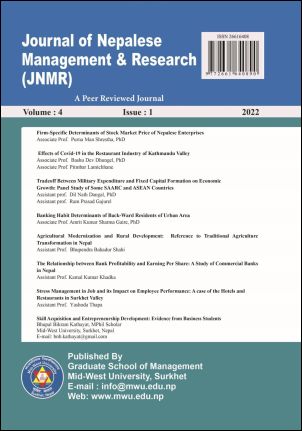The Relationship between Bank Profitability and Earning Per Share A Study of Commercial Banks in Nepal
DOI:
https://doi.org/10.3126/jnmr.v4i1.52781Keywords:
earning per share, return on assets, return on equity, net profit marginAbstract
This quantitative study seeks to evaluate the relationship between bank profitability and earning per share (EPS) in Nepal. The 200 observations data for the study was gathered from the financial statements of 10 sample commercial banks out of 27 working in Nepal during a five-year period, from 2016/17 to 2020/21. The type of data included panel data and it consisted of secondary sources. In order to determine the relationship between the two, Pearson correlation was used. The effect of banks’ profitability on earning per share (EPS) was analyzed by using multiple linear regressions. The central tendency of the variable was also investigated using descriptive analysis. The results indicated that there is positive relationship between dependent (EPS) and independent variable (ROA, ROE, & NPM). However, return on assets and net profit margin had an insignificant impact on earnings per share and significant impact of return on equity on earning per share. Further, the 59.90 % of the variation in earning per share is explained by the predictors like return on equity, return on assets and net profit margin. The remaining 40.10% of variations are explained by other factors than return on equity, return on assets and net profit margin. Finally, this paper shows new insights for policy makers to improve the financial performance and also helps to investors, and shareholders for take right decision on commercial banks in Nepal.




